| Big Block Chevy Spark Plugs |
|
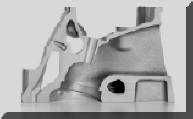
MIG Gas Delivery and the Small Block Chevy
Evolved in a Similar Way and Time!
Both
had Advances and Setbacks Before
They Were Optimized! 
Click
for a PDF Report on the Similarities |
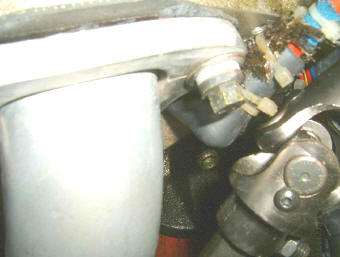 Chevy's 502/502 comes with AC
Brand Rapid Fire #4
spark plugs. A unique problem
created when building the Pro Street Rod required the use of
another plug. If your having
heat range problems with a street/strip ride the solution developed may be
of interest. Chevy's 502/502 comes with AC
Brand Rapid Fire #4
spark plugs. A unique problem
created when building the Pro Street Rod required the use of
another plug. If your having
heat range problems with a street/strip ride the solution developed may be
of interest.Stuffing a Big Block Chevy in a '34 Ford requires some
careful planning. During construction, some old plugs were put in the
engine so debris did not get into the cylinders. When the steering
column was being installed it was put very close to the engine to have the
steering wheel placed as far right as possible. |
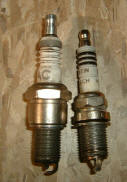
The above picture shows how close the left rear plug is to the steering
shaft
universal. All would have been fine if that old set of spark plugs had
been standard length! But they were not! They were Bosch
platinum from an old Jaguar! See the photo at left of the AC plug supplied
and the 1/4 inch shorter Bosch! A 1/4 inch isn't much but it might as
well be a mile when you don't have room!! What to do? Started
the engine with 7 AC's and one old Bosch! After examining the plugs, even the AC's looked like
they were too "cold." They were probably fine
on the Dyno at full throttle, but that's not how one drives on the
street. But when you put your foot to the floor you don't want to preignite, blow off the plug tip or worse! |
| The solution. Find out which Bosch Plug would work! That's
not as easy as it sounds. All the info on plug types and fitments ask
for car, engine etc. Not much help for a 502/502. Found a fellow
who sells Bosch Racing Plugs in NY but he wanted to sell only in lots of 100!
Finally found a Bosch Tech Line 1-800-521-5462. They were very helpful
in defining the heat range, size etc. |
For example, the FR7DPX finally selected means:
- F = 14mm plug with 5/8 hex head.
- R = resistor plug
- 7 is the heat range. For Bosch 1 is the coldest and 11 the hottest.
Some racing plugs can be less than 1.
- D = reach which for what is needed for the 502/502 is 0 .708 tapered
seat extended tip
- P = platinum
- X = gap = 0.044 inches
|
| Getting to the correct heat range required trial and
error. In fact at one point it was thought
one plug would be needed for the summer and another for the winter! |
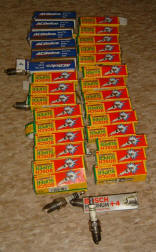 Tried a
few Bosch standard copper core plugs; # FR6DCX which ran OK in the summer
but was too cold in the winter (black at the bottoms.) They also
fouled a few times and required removal and cleaning. Switched to
FR8DCX which are two heat ranges hotter but when examined, a few appeared to be excessively
hot. Tried a
few Bosch standard copper core plugs; # FR6DCX which ran OK in the summer
but was too cold in the winter (black at the bottoms.) They also
fouled a few times and required removal and cleaning. Switched to
FR8DCX which are two heat ranges hotter but when examined, a few appeared to be excessively
hot.
Thought the Platinum would have a larger heat range. The Bosch
technician agreed and with his help the FR7DPX was selected. They have worked very
well for several years. No fouling (as long as one does not push your
foot more than about 1/4 throttle when starting a old engine.) The plug porcelain is a nice tan color on most plugs with a few slightly
black, cylinders # 4 and # 2 that are running a bit richer.
|
|
Thought
spark plug selection was resolved! However although the FR7DPX's were
performing well for about 3000 miles, at the last Street Rod Show of 2005
(that ended at 9 PM), the temperature was cold. The accelerator
was mistakenly given a full pump- -big mistake! The car missed the 16 miles
home. Next day checked and # 5 plug was fouled. Cleaned it and
all was fine. Getting ready for the 2006 season the car was started
after a several months layoff. It missed for the short trip so it was
back in the garage.
This time the front two plugs on
the right side, #'s 2 & 4 were very dark gray to black. These were the
culprits. Plug # 3 also showed a lot of dark gray. Decided to
put a set of Bosch FR8DCX in all cylinders. These are a heat
range hotter and copper center core construction. The NGK's used for
several Corviairs were one of the first to use this approach.
It does extend the heat range.
Since there is a good deal of
Internet Traffic on this page - - keep you posted on results.
First 10 mile run was perfect, started very quickly with only enough
accelerator peddle movement to have the electric choke set! Subsequent
starts were also fine.
Two years
have passed and had a plug fouling episode again. Probably my fault
but found a new Bosch Plug. Similar to what I have been using it
is called Super Plus and they add Yttrium!! It appears Yttrium in very
small quantities improves the ductility of copper. Perhaps it
helps in production with the copper / nickel alloy center electrode joint.
Perhaps it's always been there and some marketing type just labeled it
different! Since it was time to at least check the plugs and I found a deal on Amazon for $1.37 each-decided rather than
just check the plugs would install new ones! (They list for $4.90
each!) The Bosch part number is 7957. The old plugs actually
looked OK. Six of the old plugs were a nice tan color and two were
gray with some black.-cylinders 4 and 6. Keep you posted on
results. |
|
Note: We're "hitchhiking" on our commercial web site to bring you this information on
Big Block Spark Plugs. Many "Car Buffs" have purchased our 6 foot prefitted
Shielding Gas Saver
for their MIG welders. We also added 3
and 4 foot systems for smaller MIG welders,
Part Numbers WAT-FB3 & FB4 |
|
This Ad Helps Bring You
Free Information on Welding Race Cars & Street Rods
Have a Welder? Improve Weld Starts and
Have Shielding Gas Cylinder Last at Least Twice as Long!
Note: Our Patented
GSS
is Not Available in "Stores"
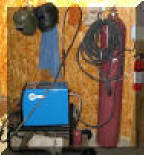
A home shop fabricator
in Georgia with a Miller TM 175 amp welder
purchased a 50 foot Gas Saver System ( GSSTM
) so he could use a larger cylinder
and mount it on the wall of his shop. He wrote:
"The system works great.
Thanks for the professional service and
a great product."
Click To See His Home Shop
A Professional
Street Rod Builder Had This to Say:
With their standard MIG welder gas delivery hose the
peak shielding flow at weld start was measured at 150 CFH. That caused air
to be sucked into the gas stream causing poor weld starts. With the
GSS replacing their existing
hose, the peak flow surge at the weld start was about 50 CFH. Total gas use
was cut in half.
Kyle Bond, President, quickly saw the improvement
achieved in weld start quality as a significant advantage! Kyle, an
excellent automotive painter, was well aware of the effects of gas surge
caused by pressure buildup in the delivery hose when stopped. He has to
deal with the visible effects in the air hose lines on the spray gun in his
paint booth! The paint surge is visible and creates defects unless the gun
is triggered off the part being painted! We can’t do that with our MIG gun!
|
|
|